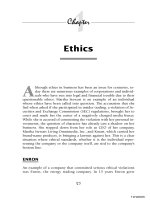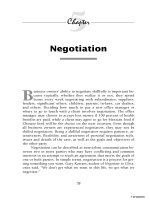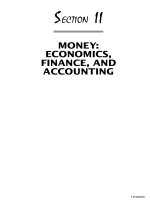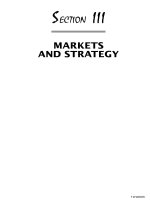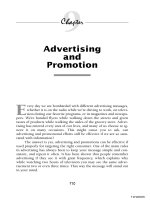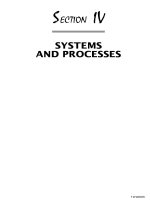MBA In A Day Chapter 8 ppsx
Bạn đang xem bản rút gọn của tài liệu. Xem và tải ngay bản đầy đủ của tài liệu tại đây (301.36 KB, 27 trang )
SECTION III
MARKETS
AND STRATEGY
ccc_stralser_seciii_143-144.qxd 7/22/04 9:06 AM Page 143
TLFeBOOK
ccc_stralser_seciii_143-144.qxd 7/22/04 9:06 AM Page 144
TLFeBOOK
8
Marketing,
Strategy, and
Competitive Analysis
W
e’ve all heard someone in the course of business say that
“marketing is fluff and hype.” However, the wisest, most
savvy, and most successful businesspeople understand that
marketing is far from that. Marketing is everything you do on a daily
basis to sell a product or provide a service to a customer. Marketing en-
compasses every way in which a customer perceives a business and
everything that generates enough interest from a customer and encour-
ages customers to actually pay for the product or service. As Peter
Vessenes suggests, cash may be king, “but marketing is everything.”
What does it really mean to market your service or product? Of-
ten, people immediately equate marketing with advertising and see
only the amount of money that advertising will cost. However, by defi-
nition, marketing is actually the process by which we offer goods or
services up for sale. Forward-thinking marketing strategists suggest
that marketing is not a “cost” or “expense” but rather an investment,
because much of the benefit of marketing is longer-term and may take
years to fully provide its benefit.
Marketing has also been referred to as a social and managerial
Chapter
145
ccc_stralser_ch08_145-169.qxd 7/22/04 9:07 AM Page 145
TLFeBOOK
process by which individuals and groups obtain what they need and
want through creating, offering, and exchanging products of value
with others. Additionally, it is all too often equated only with the
more focused function of selling. But marketing encompasses a
wider range of activities that must be a fully integrated process
and, indeed, will form a foundation and catalyst for making sales.
Further, the key to successful sales is a consistent proactive market-
ing strategy.
MARKETING’S KEY COMPONENTS:
CREATING VALUE FOR THE CUSTOMER
What, then, is the key to a consistent proactive marketing strategy?
First and foremost it is a philosophy that dedicates resources of the
firm to ensuring that the wants, needs, and demands of the customer
are the firm’s focus. This customer-focused mentality is the foundation
of the strategy that makes up the entire marketing process.
Second, it is a plan, supported by the firm’s philosophy. Once
the philosophy is in place, a plan can give direction, guidance, and a
structure for proactive strategies that will increase sales and improve
business relationships. Often firms find themselves dedicating re-
sources to marketing activities—from trade shows to flyers—and
spending money on marketing that is not targeted to the right audi-
ence at the right time. This is reactive marketing with a shotgun,
rather than a rifle. Conversely, a proactive, focused marketing plan
can provide guidance for targeting the right audience at the right
place and at the right time, which in turn maximizes the return on
investment and increases revenues.
Third, marketing is a process of creating value for the customer.
It is a set of activities to educate, communicate with, and motivate the
targeted consumer about the firm’s services or the company’s product
and services.
Traditionally, this set of activities, the “marketing mix,” is repre-
sented by four parts, the well-known “4 P’s of Marketing”: price, prod-
uct, placement, and promotion. But to create a marketing strategy and
plan that touch on all areas necessary to position a product in the mar-
ket to maximize sales revenues, there are multiple areas to be tackled.
MARKETS AND STRATEGY
146
ccc_stralser_ch08_145-169.qxd 7/22/04 9:07 AM Page 146
TLFeBOOK
An effective marketing strategy/plan is an ongoing value-creating
process composed of several elements:
✔ Marketing segmentation.
✔ Marketing strategy.
✔ Market research.
✔ Pricing.
✔ Placement.
✔ Value chain.
Market Segmentation
One of the first steps in developing an overall marketing strategy is to
perform a market segmentation analysis, as a way to manage the strat-
egy development process and ensure its effectiveness and success. The
concept behind market segmentation is intuitive and relatively simple.
Market segmentation is simply taking a look at the overall market for
your product and service and thinking of it in terms of smaller, more
manageable pieces.
Think of market segmentation as what Bert and Ernie from
Sesame Street sing about when they suggest “One of these things is not
like the other . . . one of these things doesn’t belong.” In a sense, that’s
what we are doing when we segment a market—we are looking at the
whole and trying to determine how we can group the mass market into
smaller groups that, while different from each other, within the groups
are more alike.
Once we have identified these subgroupings, we can target which
of these market segments are likely to be the most productive and be
the best fit with our company’s strengths and competitive advantages.
A well-used example of market segmentation is the way the play-
ers in the hospitality industry look at the market for hotel/motel
rooms. Rather than take a “one size fits all” approach to this market, a
company like Marriott looks at the overall market and segments it into
several smaller, but more focused market segments. For the “travel and
leisure” segment of the overall hotel/motel market, Marriott’s Fairfield
Inn is located near major tourist attractions, is budget priced, and ap-
peals to families. For the middle-level manager who travels a lot and
Marketing, Strategy, and Competitive Analysis
147
ccc_stralser_ch08_145-169.qxd 7/22/04 9:07 AM Page 147
TLFeBOOK
wants some comforts of home while on the road, the Courtyard by
Marriott is located near businesses and has a residential “feels like
home” atmosphere. For CEOs and top-level executives, Marriott’s Ritz-
Carlton has all the upscale amenities and top-level customer service
that presidents and CEOs of business and industry are used to and ex-
pect when they travel. Note in these examples how Marriott has bro-
ken this overall mass market into more manageable, more focused
segments, and, importantly, how its marketing strategy for each seg-
ment is tailored to that segment.
By applying the principles of market segmentation, marketers can
make better use of their marketing budgets and more efficiently man-
age their overall marketing strategy.
Marketing Strategy
To build a strong and durable house, it is necessary to create blue-
prints. Likewise, to build a strong and profitable business, it is neces-
sary to develop a strategy. Essentially, marketing strategy is a plan that
allows a business owner to direct activities that are consistent with the
goals of the business owner and organization and spend money wisely
in order to create the greatest amount of return on investment.
Market Research and Competitive Intelligence
To thoroughly understand what is happening in the industry in which
you operate, it is invaluable to know what the trends in the industry
are as well as what the firm’s competitors are doing to make money, to
improve their businesses, and to improve their own market shares.
Market research is necessary to make better firmwide decisions. With
marketing being a philosophy where the resources and activities of the
firm or company are focused on satisfying the wants and needs of the
customer, marketing research is the way a firm with a marketing phi-
losophy determines what those wants and needs may be, and further,
how to communicate the associated benefits most effectively and effi-
ciently. Additionally, market research is used to monitor and modify, if
needed, the elements of the marketing strategy. Market research in-
cludes: defining the problem and research objectives, developing a re-
search plan, presenting the plan, implementing the plan (collecting
MARKETS AND STRATEGY
148
ccc_stralser_ch08_145-169.qxd 7/22/04 9:07 AM Page 148
TLFeBOOK
and analyzing data), and interpreting and reporting the findings. This
is the area of marketing where we begin to see science as well as art.
This chapter focuses in detail on how to research a market, how to
know the competition, and how to leverage that knowledge to improve
your business.
Pricing
To sell a product for a particular price, value must be created. Value is
the consumer’s estimate of the product’s overall capacity to satisfy
his/her needs. When the value placed on a product or service is high,
then satisfaction is achieved. Consumers are savvy and will choose
based on the level of satisfaction that corresponds with the price. If a
bottle of Coca-Cola were priced at $5 while a liter of Pepsi-Cola was
priced at $1, it is likely that the sales of Coke would decrease. If these
were the only two options at the supermarket, the likelihood of Pepsi
sales increasing is high. Pricing is what your customer is willing to
trade in return for a product—that is, the value they place on a product
or service. Generally, a “price/quality” relationship exists, where the
higher the price, the higher the quality; especially in the case of per-
sonal services, consumers will expect a higher level of service if the fee
associated with that service is higher relative to other providers of sim-
ilar services.
Marketers may elect to skim the market with a relatively high
price at first, and then, as demand wanes at this relatively high price,
gradually lower the price. New, innovative products often use this pric-
ing strategy because their newness and uniqueness may enable a
higher price at first. As copycats and competitors enter the market,
prices will fall to meet the market price.
Some marketers, though, may use a penetration strategy, where
the product or service is offered at a very low price, in order to quickly
grab market share and be considered the low price provider. Wal-Mart
is an example of a company using a penetration pricing strategy.
Pricing is a powerful tool in developing a marketing strategy with
a strong connection to the financial condition of the organization.
Pricing too low may result in economic consequences if costs are not
covered, and pricing too high may stunt demand and sales of the prod-
uct or service, also resulting in adverse economic consequences.
Marketing, Strategy, and Competitive Analysis
149
ccc_stralser_ch08_145-169.qxd 7/22/04 9:07 AM Page 149
TLFeBOOK
Placement
A customer will not likely purchase a service or product unless it
can be relatively easily accessed. Placement can be anything from a
magazine or candy bar sitting next to the checkout counter at the
supermarket—a spontaneous purchase—to gas stations situated on
the right-hand corner of the exit from a highway or to the location
of a orthodontics office in the same complex as a pediatrician’s of-
fice. Placement helps make the purchasing process for a customer
easier and more convenient. Often the term distribution is used
interchangeably for the placement component of a marketing strat-
egy and includes the decisions a company or firm must make to
ensure the connection with the customer or client. Placement is
how the marketer connects the products or services with the cus-
tomer—the easier, more convenient, more accessible the product or
service may be, the more likely the customer will purchase the prod-
uct or service.
Value Chain
All of the aforementioned parts of the marketing plan cannot be car-
ried out to the full level of effectiveness without all areas—a value
chain—working together. Generally, the value chain includes the fol-
lowing activities:
✔ Inbound logistics—bringing raw materials into the business.
✔ Operations—management of processes to create the product or
service for the customer.
✔ Outbound logistics—the means for getting the product or ser-
vice to the customer (for example, distribution systems and
shippers to get products into retail stores).
✔ Marketing and sales—creating value.
✔ Service—aligning customer expectations and the performance
of the product or service.
✔ Firm infrastructure—the organization of the firm to maximize
service to the customer.
MARKETS AND STRATEGY
150
ccc_stralser_ch08_145-169.qxd 7/22/04 9:07 AM Page 150
TLFeBOOK
✔ Human resources management—creating a structure for the
people in the firm, which includes recruitment, training, re-
tention, and compensation of employees.
✔ Technology—using technology to maximize service, thereby
enhancing customer value.
MARKETING AS AN INVESTMENT
Successful companies that become excellent marketing organizations
know themselves, their customers, and what they offer that fills the
customers’ needs. This requires an investment of time and money to
accurately determine whether all three parts of the triangle fit together.
As an example, ABC Company is about eight years old and oper-
ates in the online professional services industry. The customer wants
and needs this service. Most importantly, the customer is willing to pay
for the service and ABC Company is the only company occupying this
space at this time. One would imagine that ABC Company is generat-
ing a strong and regular revenue stream. Unfortunately, ABC Com-
pany’s CEO does not believe in investing in consistent marketing
strategies and targeted marketing initiatives. Rather, the CEO pays low
wages to inexperienced salespeople who have no incentive or support
to sell the service. Therefore, due to a lack of investment in marketing,
the customer does not even know that ABC Company exists. The fall-
out of such poor strategic thinking could be that employees often are
not paid in a month, morale plummets, and company reputation lags.
BECOMING A MARKETING
ORGANIZATION: BE TRUE TO YOURSELF
As set forth in the preceding sections, marketing is the process
of building a strategic plan. However, without buy-in from the orga-
nization as a whole, becoming a marketing organization is more
challenging.
A marketing organization is not a firm that sells marketing ser-
vices. A marketing organization is a firm—regardless of industry,
Marketing, Strategy, and Competitive Analysis
151
ccc_stralser_ch08_145-169.qxd 7/22/04 9:07 AM Page 151
TLFeBOOK
function, size, or region—in which all levels of the organization ad-
here to the same ideals and uniform methods for attaining customers.
As an example, Southwest Airlines has created a marketing organiza-
tion. It has three company “policies”:
✔ Practice the Golden Rule. We have a choice every day and
choose to make our employees our first customers and our
passengers our second customers.
✔ Help each other out.
✔ Feel free to be yourself.
Integrate, Integrate, Integrate
Southwest ensures that these messages as well as any marketing mes-
sage is integrated throughout every part of the organization and in
every point of contact with the customer—noting that the customer is
both the Southwest employee as well as the purchasing passenger. This
ability on Southwest’s part to create a marketing organization—or a
marketing culture—allowed it to weather economic downturns and
adverse industry trends.
Becoming a marketing organization also allows the entire team
to understand the value of the firm’s products to the customer and
behave in a manner in which selling is a way of life. For example, a
consulting firm may have strategic consultants working on projects
at the client’s office. Because of this situation, the consultants are
able to observe the client’s business processes at every stage, and
thus have an inside view of the needs of the client. This can create
an “upsell” opportunity. Upselling is the process of adding a product
or service to an existing project. For all marketers, gaining more
share of an existing customer is a more effective overall marketing
strategy than working hard to find more customers. Customer or
client loyalty is a much smarter long-term strategy, because satisfied
customers become “salespeople” in attracting new customers. Addi-
tionally, satisfied customers have trust and confidence in your firm’s
offerings and are more likely to buy more, buy more often, and, be-
cause of the lower marketing costs associated with existing cus-
tomers, become more profitable. The most expensive customer to
MARKETS AND STRATEGY
152
ccc_stralser_ch08_145-169.qxd 7/22/04 9:07 AM Page 152
TLFeBOOK
acquire is a new customer; the most cost-efficient customer is an ex-
isting one.
If the employee doesn’t “get it,” the customer won’t.
There are numerous ways that all businesses can become market-
ing organizations and create buy-in on all levels.
✔ Communication. A firm may ensure that decisions are commu-
nicated quickly and honestly on all levels of the company so
that employee questions, fears, and rumors do not erupt.
✔ Training. Training is important to ensure that every employee
knows exactly what the firm does to generate revenue and
what impact that individual has on that process. Ongoing
training in customer service at all levels of the organization
will add greatly to the effectiveness of the company’s market-
ing strategy.
✔ Tools of the trade. People take action when empowered with
the right tools to do so; therefore, it is important to create the
tools to make each employee’s job easier—whether it be a
technological system or a brochure to distribute to customers
or the process to do his/her job with clarity.
STRATEGY
In short, strategy is a bridge that connects a firm’s internal environ-
ment with its external environment, leveraging its resources to adapt
to, and benefit from, changes occurring in its external environment.
Strategy is also a decision-making process that transfers a long-
term vision into day-to-day tactics to effect the long-term plan. Al-
though often thought of only as something reflected in a business
plan, strategy is rather a continual process of assessment, reassess-
ment, and analysis, which constantly provides direction to the firm.
Strategy can be compared to the captain on the bridge of a ship, who
is constantly scanning both the horizon and the immediate surround-
ings and adjusting the course, possibly taking the ship in another di-
rection if a storm appears on the horizon or if an object appears to
obstruct the path.
Marketing, Strategy, and Competitive Analysis
153
ccc_stralser_ch08_145-169.qxd 7/22/04 9:07 AM Page 153
TLFeBOOK
POSITIONING AND STRATEGY
The position the firm fills in the marketplace is an integral part of the
strategic process. Positioning can also be thought of as how the firm
will stake a claim in a piece of the marketplace in a manner that will
differentiate it from competitors. The key to sustainable strategy and
positioning is an integrated marketing system. Competitive advantage
comes from the ability to identify the firm’s position, make strategic
plans, and engage an entire integrated marketing system. All activities
of the firm should fit together and complement each other to produce
a well-oiled machine, which creates differentiation in the customer’s
mind and competitive advantage.
Strategy involves all areas of the firm from operations to finance
to human resources. Choosing the right strategy for the right people
for the right goals is challenging yet provides an overarching message
for the entire organization. The strategy and message must then be
communicated consistently and clearly throughout the firm for its ef-
fectiveness to take effect and produce a sustainable organization.
TACTICS
While strategy is the overall direction, the long-term mile markers,
and/or the guiding force of how the organization moves forward, tac-
tics are the specific steps that are taken to implement the strategy.
Strategy tends toward the longer term; tactics are the shorter-term
steps taken to achieve the long-term strategy.
For example, XYZ Company is a health and fitness center.
Strategically, the firm leadership has decided to develop a center tar-
geted at the 30 to 65 year-old woman and create a comfortable envi-
ronment in which she can exercise, lose weight, and learn more
healthy life habits. The firm’s strategic geographic positioning is to
provide centers in suburban areas where the largest number of these
women live. The tactics used for carrying out this strategy include
developing consistent messages and advertisements reflecting the
mission of the firm targeted to this market segment, hiring other
women trainers so the women customers will be comfortable, and
MARKETS AND STRATEGY
154
ccc_stralser_ch08_145-169.qxd 7/22/04 9:07 AM Page 154
TLFeBOOK
providing health and fitness educational materials specific to the ma-
ture woman customer that will create a relationship between XYZ
Company and this market segment.
PEST ANALYSIS
Although easy to remember and easily forgotten by firms in developing
a long-term strategy, a “PEST analysis” is an acronym for analyzing the
external environment (political, economic, sociological/demographic,
and technological) and setting the stage for strategic planning. Also
known as “environmental scanning,” the PEST analysis reviews the en-
vironment of a market—whether emerging or existing—and provides a
snapshot of the external situation that may impact an industry or the
firms within that industry.
Political Environment
Often considered more relevant when entering a foreign market,
the political situation in any new or existing market is invaluable
to study and understand. Existing government policies and regu-
lations can deter new entrants into an economy, particularly in
underdeveloped or developing areas of the world, or can swiftly
affect incumbents in an industry with new regulations and poli-
cies that can have both positive and negative results. For example,
even though the Graham-Leach-Bliley Act in the 1990s in the
United States repealed the New Deal era Glass-Steagall Banking
Act and allowed some financial companies to expand their ser-
vices, it also impacted those firms because they were not permitted
to sell both institutional and investment services. Likewise, the
Sarbanes-Oxley Act of 2002 prohibited firms such as those in ac-
counting and financial services from providing consulting and au-
diting services. Additionally, government policies can add extra
expense to firms; for example, the HIPAA regulations of the late
1990s required health-care organizations and all related firms to
protect patient information, which led to increased costs to these
providers.
Marketing, Strategy, and Competitive Analysis
155
ccc_stralser_ch08_145-169.qxd 7/22/04 9:07 AM Page 155
TLFeBOOK
Economic Environment
The economic health and welfare of a state, nation, or region also im-
pact the firm’s decision-making process. If an area is healthy economi-
cally and the consumers in a region have the means or potential means
for creating purchasing power, then a company may want to consider
selling its product or service in that area.
Sociological/Demographic Environment
In this part of an environmental scan, we look at trends and factors of
the population of our market—for instance, societal attitudes or popula-
tion shifts that represent either opportunities or threats to our overall
strategy. Included in this portion of the analysis is perhaps the education
level of the local market, in terms of creating both a workforce and a cus-
tomer base for the firm. If the levels are too low, then the cost of creating
training programs for potential employees and educational marketing
methods for potential customers should be taken into consideration.
The aging of the baby boomer demographic has affected the strategies of
many organizations; interestingly, AARP has responded recently by be-
coming “more hip” in its image as a way to woo boomers who, prior to
their arrival into AARP age range, have parodied its existence.
Technological
Technology refers not only to technology as it is thought of today with
computers and systems to manage business more effectively, but also
to the infrastructure necessary to support modern systems and
processes. Certainly the diffusion of Web-based technology has af-
fected most organizations, giving even the smallest a global presence
and a cost-effective way to reach millions of potential customers. Thus,
the strategy of an organization may be affected by technological
change, and the velocity of technological change also means this vari-
able must be monitored constantly. Certain areas of the world—even in
the United States—cannot support systems without great build-out ex-
pense and investment. A firm must look at the condition of the host
country or region’s communication, transportation, and power sys-
tems, as well as the cost of using those systems. If the condition and
MARKETS AND STRATEGY
156
ccc_stralser_ch08_145-169.qxd 7/22/04 9:07 AM Page 156
TLFeBOOK
cost are adequate, then the quality of the end product or service and
the reliability of consistently providing the firm’s product or service to
the end user/customer must be analyzed.
THE MODEL FOR STRATEGIC
THINKING: PORTER’S FIVE FORCES
In the 1970s, Harvard economist Michael Porter created the gold stan-
dard for how strategy is created and analyzed today. Referred to as
Porter’s Five Forces, this method analyzes the industry and competi-
tive environment in which a firm operates. When developed correctly,
the framework paints a picture of the current environment in which
the firm competes, allowing the firm to see the big picture and, in turn,
develop long-term strategies for the company that will lead to effective
decision making and sustainability. Porter believes that an industry’s
potential profitability can be expressed as a function of these five forces
and that one can therefore determine the potential success of a firm in
that industry. Porter’s Five Forces provide a model for reviewing the
outside environment portion of the strategy bridge and for determin-
ing the attractiveness of a particular activity at a particular moment in
time. This model can be used on any firm of any size in any location in
any industry and can be utilized regularly to keep a constant eye on
the market, the direction of the market, and the competitors coming
and going within that market.
The essential elements of Porter’s analytical framework are:
1. Barriers to entry.
2. Threats of substitute products or services.
3. Bargaining power of suppliers.
4. Bargaining power of consumers/buyers.
5. Rivalry among competitors.
Barriers to Entry
Barriers to entry refer to forces that deter companies from entering a
particular market. In general terms, one will hear such references as
Marketing, Strategy, and Competitive Analysis
157
ccc_stralser_ch08_145-169.qxd 7/22/04 9:07 AM Page 157
TLFeBOOK
“The barriers to entry in the telecommunications market are extremely
high” or “The barriers to entry in the ice cream industry appear to be
quite low.” Barriers to entry are just as important for firms that are
incumbent in an industry as well as to the newcomers because of the
threat of new entrants.
The barriers generally observed by Porter include economies of
scale, product differentiation, capital requirements, cost disadvantage
independent of size, access to distribution channels, and government
policies (regulation).
Economies of Scale. These refer to the ability of a firm to mass
produce a product and therefore to sell to the customer at a lower
price. A competitor that does not have the luxury or means to mass
produce would thus not be able to compete on price, but rather be
forced to find another way to differentiate itself from the competition
to the consumer.
Product Differentiation. This is the method or tactics used by a
firm to give its product a more recognized value than the competitors’
products. Brand identity is a powerful tool in creating value and there-
fore makes it difficult for a new entrant into the market to gain cus-
tomer loyalty. For example, the leaders in the toothpaste market are
Colgate and Crest. Customers tend to be loyal to their toothpaste
brands, and it would require heavy expenditures to draw customers
away from either of those brands. In addition to brand identity, adver-
tising, first mover advantage (being first in an industry), and differ-
ences in products also foster loyalty to products and can easily make
entering a market highly expensive.
Capital Requirements. These refer to the amount of money and
investment necessary to enter a market. Not only does this reference
the product differentiation and brand loyalty mentioned earlier, but
it is also extremely important in an industry in which the infra-
structure to produce the product requires large amounts of financial
resources. Both telecommunications and aviation are examples of
industries that require investment in machinery, technology, and
so on.
MARKETS AND STRATEGY
158
ccc_stralser_ch08_145-169.qxd 7/22/04 9:07 AM Page 158
TLFeBOOK
Cost Disadvantage Independent of Size. Some industries
have a high learning curve, whether that is scientific, technological,
or experiential. In other cases, companies in a particular industry
may have access to raw materials, lower prices, advantage based on
history or relationships, favorable locations, or even the benefit of
government subsidies. All of these factors can affect the ability for
an up-and-comer to set up business, get access to capital, and even
be profitable.
Access to Distribution Channels. Incumbents in an industry
have relationships that may have been functioning profitably for all
parties for years. New entrants to that industry have the challenge of
creating new relationships or even new and creative methods of dis-
tribution just to get their products to market and in front of the con-
sumer. This may mean using price breaks, innovative marketing,
and creative product differentiation. For a service industry, this may
refer to selling relationships or even a location of the service or
place in society. For example, some law firms build relationships
with clients and partners that are a result of years of networking and
relationships. Business between the organizations goes back genera-
tions and new law firms in the field must be creative in reaching
the clients.
Government Policies (Regulations). The government has
power over industries in the form of licenses, limits on access to raw
materials, taxation, and even environmental regulation and standards.
Threat of Substitute Products or Services
A substitute to a product or service can be any other product or ser-
vice that serves a similar function. Too often, firms underestimate
the competitor by not realizing that the product the competitor sells
may be a substitute for its own product or service. Many failed ven-
tures during the dot-com bubble had the misconceived notion that
“we have no competition,” when, in fact, there are always products
or services that compete for a consumer or customer’s budget. The
key to a substitute is that although it may not be the same product
Marketing, Strategy, and Competitive Analysis
159
ccc_stralser_ch08_145-169.qxd 7/22/04 9:07 AM Page 159
TLFeBOOK
or service and although the competing products or services don’t
function in the same manner, the competing products meet the same
customer need. For example, sugar prices cannot go too high or
sugar substitutes such as fructose or corn syrup can be used in vari-
ous consumable products (beverages, etc.). Other industries also
have indirect substitutes such as preventative care and the pharma-
ceutical industry.
Bargaining Power of Suppliers
By controlling the quality or quantity of a product or service a firm
needs to conduct its business, or by affecting the price, a supplier can
have power over the firm and impact its ability to enter or function in a
new market. The ultimate power of a supplier comes down to the char-
acteristics of the supplier group and the relative importance of sales.
According to Porter, a supplier group is powerful—it can affect a firm
and possess control over the firm—if and when:
✔ There are fewer suppliers than buyers.
✔ Its product is unique or differentiated.
✔ The buyer group is fairly small.
✔ It has created high switching costs. Switching costs are incurred
when a customer switches from one supplier/product/service to
another. For example, when switching from one deodorant to
another, the consumer may not experience a switching cost.
However, for a company to switch from one office software
provider to another, the costs may involve human resources,
time, training, and so on.
✔ The supplier can integrate forward or take on the function of
its customers; for example, a tire manufacturer may open its
own retail stores to sell and install its tires.
Bargaining Power of Consumers/Buyers
Just as the supplier has power in the competition and market wars, the
customer has power. Customers can force down prices, demand more
service or better quality, and even pit competitors against one another.
MARKETS AND STRATEGY
160
ccc_stralser_ch08_145-169.qxd 7/22/04 9:07 AM Page 160
TLFeBOOK
As with most situations, when buyers form groups, they become pow-
erful and will remain powerful if and when:
✔ They purchase in volume. A prime example is Wal-Mart or
Costco. Not only can the customer purchase in volume, but
Wal-Mart can purchase in large volume from the supplier,
forcing down prices for the end consumer.
✔ The product is undifferentiated and the alternatives for the
buyer increase.
✔ The product that they purchase forms a component of the
product they produce.
✔ Switching costs are low.
✔ They can purchase up front.
✔ They can integrate backward.
Rivalry among Competitors
All four of the aforementioned parts—barriers to entry, the threat of
substitutes, and the bargaining power of suppliers and buyers—create
rivalry among competitors. Analyzing all of these areas provides a plat-
form for studying the competition in the firm’s market space.
COMPETITION: DON’T BE
JUST LIKE EVERYONE ELSE
Every company and every firm has competition. The competition may
be direct or indirect, but there is competition. The health club com-
petes with the television, McDonald’s competes with cooking at home,
and the design company competes with the do-it-yourselfer. The mo-
ment a firm begins to believe that it does not have competition is the
exact moment it becomes vulnerable to competition.
Competitive Advantage and the Basis for Competing
Once the firm knows who the competitors are and what they do, it
needs to carefully identify and document who it is. This is called
Marketing, Strategy, and Competitive Analysis
161
ccc_stralser_ch08_145-169.qxd 7/22/04 9:07 AM Page 161
TLFeBOOK
creating a competitive advantage. A competitive advantage is creat-
ing through differentiation and differentiation is created through
branding and imaging.
Any time a customer asks for your product by name, you have
achieved differentiation. Although theoretically simple, creating dif-
ferentiation through brand and image is not as simple as it sounds.
It is a process of identifying the firm’s strengths, weaknesses, limita-
tions, hurdles, and faulty assumptions, followed by creating a brand
that is identified by logos, tag lines, color scheme, and all those ad-
ditional elements that create a visual or recognizable memory of the
firm. The competitive advantage of a product or service also de-
pends heavily on variables such as the level of sophistication of the
product, prior experience with that product or service in a certain
country or part of a country, and the types of distribution channels
available.
Costs and Risks
Creating competitive advantage may require a high level of cost and
risk to the firm. Often, a firm will create a branding strategy that
“pushes the envelope” and increases risk both in time and in money.
However, the brand image that is created is so strong that the cus-
tomer immediately responds positively. It is imperative that the
brand or image created be aligned with the firm’s strategic initiatives
and goals.
Creating a Perceived Value
There are two packages of cheese, both of which are produced at the
same factory. One is sold at the supermarket for $3.50 and carries a
brand name. The other package of cheese is a generic brand and sells
for $2.50 before the store gives a “VIP card” (frequent shopper) dis-
count. It is the exact same cheese with different labels. However, mil-
lions of Americans buy Kraft over the store brand because it is a brand
they can trust. This is what is referred to as “perceived value.” The cus-
tomer has no idea that the cheese comes from the same plant, has the
same ingredients, and is probably even packaged at the same location.
MARKETS AND STRATEGY
162
ccc_stralser_ch08_145-169.qxd 7/22/04 9:07 AM Page 162
TLFeBOOK
It is even possible that the same truck delivered both cheeses to the
grocery store. The value is not in the cheese, but in the trust that the
customer places in a company with which he/she can identify.
The SWOT Analysis: Identifying Firm SWOT
Once the competition and the industry have been assessed, a firm may
wish to perform a SWOT analysis. SWOT stands for strengths, weak-
nesses, opportunities, and threats. The strengths and weaknesses are
internal factors, whereas opportunities and threats are external factors.
A SWOT analysis can be as high-level or detailed as necessary to un-
derstand and bring to light the challenges and next steps for the firm in
creating strategic initiatives.
To fully understand the firm’s competitors and the competitive
environment, it is imperative that the firm compare its SWOT to its
competition’s SWOT. Most business leaders will want to ensure that a
SWOT analysis is performed on the firm at regular intervals and that
input on the SWOT is gathered from many areas of the organization, as
well as from the customer.
PERFORMING A COMPETITIVE ANALYSIS:
KNOWING THE COMPETITION INSIDE AND OUT
Once the firm’s internal strengths and weaknesses are realized and the
external opportunities and threats are identified, next it is important to
turn to a similar process of evaluating the competition. Competitor
evaluation not only gives more insight into the strategies and goals of
the competition but it also provides a bird’s-eye view of the trends and
future of the industry in which the firm operates.
Step 1. Identify the Competition
To analyze the competitive landscape, it is necessary to make a list of
those competitors that compete directly or indirectly with the firm’s
product or service by providing the same product or service to the
customer. (The need that is fulfilled by a product or service is not
Marketing, Strategy, and Competitive Analysis
163
ccc_stralser_ch08_145-169.qxd 7/22/04 9:07 AM Page 163
TLFeBOOK
necessarily the obvious. For example, in the case of a beauty salon, the
customer need is not necessarily a haircut, but rather the need to look
good and feel happy and attractive.)
Step 2. Identify the Competitors’ Strategies
Analyzing the competitors’ strategies provides the firm an indication of
current trends in the marketplace. This helps the firm determine how
to approach the customer.
Step 3. Determine the Competitors’
Objectives and Goals
This step may also be referred to as determining the competition’s “in-
ternal balance.” The key to properly assessing the competitor is to
know where its value system lies. Because each competitor is different,
it will place various levels of importance on technology, quality, cost,
market share, and mission. Understanding the competition’s objectives
can help the firm identify those things that may differentiate it from
the rest of the pack.
Step 4. Identify Competitor SWOT
In this step, it is not only important to assess the competitors’
strengths and weaknesses, just as the firm performed on itself, but it is
also valuable to recognize those opportunities and threats that may be
present for the competition. Identifying the competition’s strengths
and weaknesses allows the firm to identify and assess future moves and
initiatives that could affect both the industry and the firm, while iden-
tifying the opportunities and threats will give the firm an idea of the
kinds of outside forces that could impact the competitor and therefore
attack the firm.
Step 5. Estimate Competitors’ Reaction Patterns
Some competitors react quickly to events in the marketplace, whereas
other competitors take a different approach and react only to selective
events in the marketplace. Others are laid-back and react slowly, while
MARKETS AND STRATEGY
164
ccc_stralser_ch08_145-169.qxd 7/22/04 9:07 AM Page 164
TLFeBOOK
still others don’t show a pattern of reaction at all. Looking at these behav-
iors provides the firm a better understanding of what may occur in an in-
dustry if the firm takes certain actions or implements certain initiatives.
Step 6. Select the Competitors to Attack and Avoid
Some competitors are such large financial powerhouses that it may not
be financially feasible to attack. Some merely put up the front or the
image that they cannot be attacked. It is in this step that it is valuable
to the firm to know the competitors for which an attack strategy would
be profitable and those for which avoidance would be the best policy.
Identifying the weak versus the strong competitors will allow the firm
to make efficient decisions.
Step 7. Create a Positioning Map
To create a visual understanding of the entire competitive landscape, it is
helpful to create a positioning map to provide a visual representation of
the firm’s position compared to the competition as depicted in Figure 8.1.
Marketing, Strategy, and Competitive Analysis
165
Nordstrom
Macy’s
Multiple
Target
Full Service
Tiffany
Old Navy
Sears
Gap
Store as Brand
Wal-Mart
Limited/Low Service
FIGURE 8.1 A Positioning Map
ccc_stralser_ch08_145-169.qxd 7/22/04 9:07 AM Page 165
TLFeBOOK
Competition provides the firm the opportunity to look into the
future. Once all of the information is gathered, a firm can imagine the
competitor’s next move and either do the same if the market supports
it or take a different route, cutting the competition off at the pass. For
example, the home improvement stores Home Depot and Lowe’s are
often within minutes of each other or even right across the street. Gen-
erally, one store decides to move into an area before the other, and the
other watches and sets up shop nearby. Once the competitor has found
the location, the firm can take action.
Competition creates a sense of urgency and often increases
sales for all the competitors who are willing to put up a fight. Once
the firm’s competition is known and understood, the next oppor-
tunity for the firm is to “go deeper” by implementing competitive
intelligence.
COMPETITIVE INTELLIGENCE:
WHAT CAN YOUR COMPETITION DO FOR YOU?
Competitive intelligence (CI), also referred to as business intelligence,
is often seen as the business world’s secret agent 007. Although no spy
planes or pinpoint cameras are used, competitive intelligence is, ac-
cording to the Society for Competitive Intelligence Professionals
(SCIP), “a systematic and ethical program for gathering, analyzing,
and managing external information that can affect [the firm’s] plans,
decisions, and operations. Specifically, [CI] is the legal collection and
analysis of information regarding the capabilities, vulnerabilities, and
intentions of business competitors, conducted by using information
databases and other ‘open sources’ and through ethical inquiry.” In
other words, CI is the company’s radar.
Companies use CI for any number of reasons: assessing a com-
petitor’s strategies, defining the competitive landscape, discovering and
assessing trends in the industry, or identifying new opportunities that
may not have surfaced earlier in the competitive analysis process. CI
is not market research, as it is more forward looking, nor is it indus-
trial espionage, because it is legal, but rather a systematic and timely
MARKETS AND STRATEGY
166
ccc_stralser_ch08_145-169.qxd 7/22/04 9:07 AM Page 166
TLFeBOOK
process for understanding the current competitive environment. When
combined with internal firm analysis, CI can provide a manager with a
more complete picture of the decisions that need to be made to retain
the firm’s competitive advantage.
CI is valuable for many reasons. It can both help decrease the
possibility for risk and help the firm avoid unnecessary or additional
costs. In terms of savings, it can increase revenues and save time,
which translates into cost savings. CI also provides information for
innovation, product development, and targeted marketing by vali-
dating trends, clarifying events, and providing discovery and in-
sightful information.
Because any effective strategic marketing plan requires that a
firm keep close track on a regular basis of the competitors’ plans and
actions, there are a number of ways that CI can be done. To find out
information about the competition, the following are a few obvious
or not-so-obvious places where information about the competition
can be found:
✔ Annual reports. Annual reports of publicly held companies are
an obvious and easily accessible way to learn how a competi-
tor is revealing itself to its shareholders.
✔ Press releases. Most firms distribute press releases to generate
public relations. Often, the firm will post these on its web site.
It is advisable to review the press releases over a few months’
time to get a big picture view of where the competitor’s strat-
egy is heading.
✔ Trade magazines. Trade magazines provide an up-to-date and
in-depth analysis of the industry and where that industry ap-
pears to be headed.
✔ Vendors/partners/customers. Another source of solid competi-
tor information is the patterns of vendors, partners, and cus-
tomers.
✔ Salespeople. Salespeople are often very willing to talk about
their companies and provide information that provides insight
into the direction the competition is heading.
Marketing, Strategy, and Competitive Analysis
167
ccc_stralser_ch08_145-169.qxd 7/22/04 9:07 AM Page 167
TLFeBOOK

